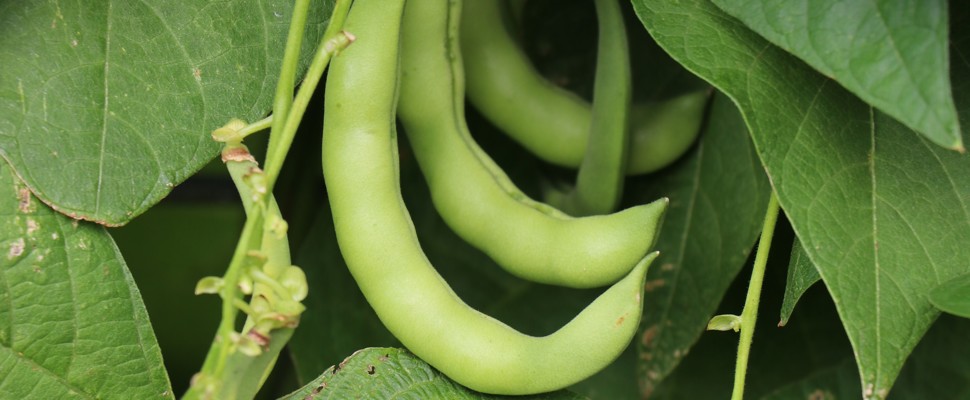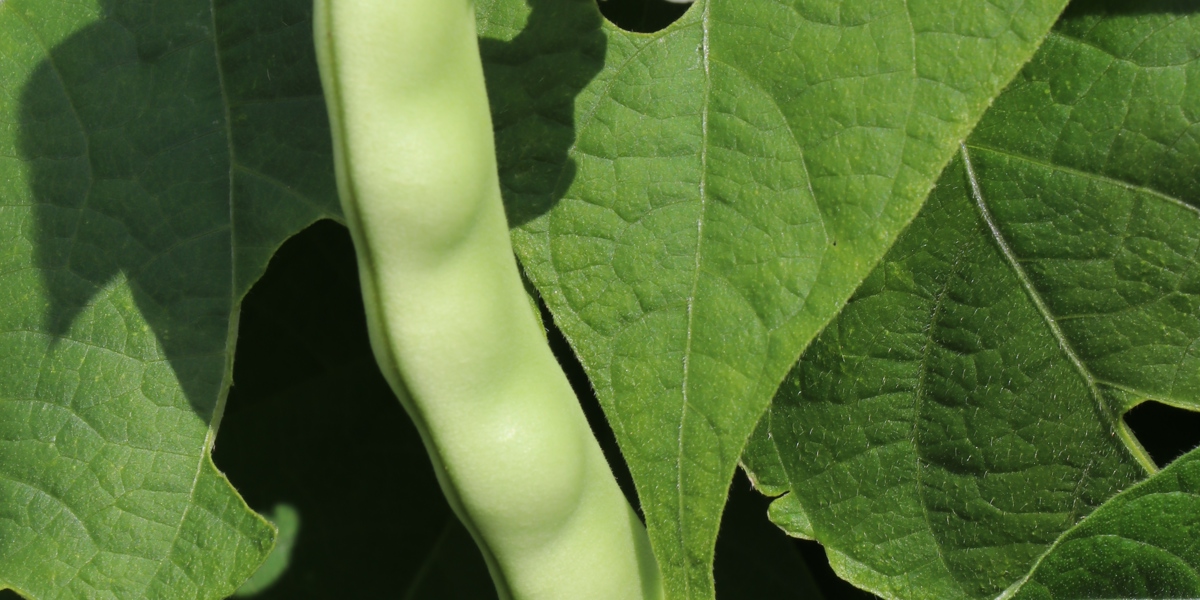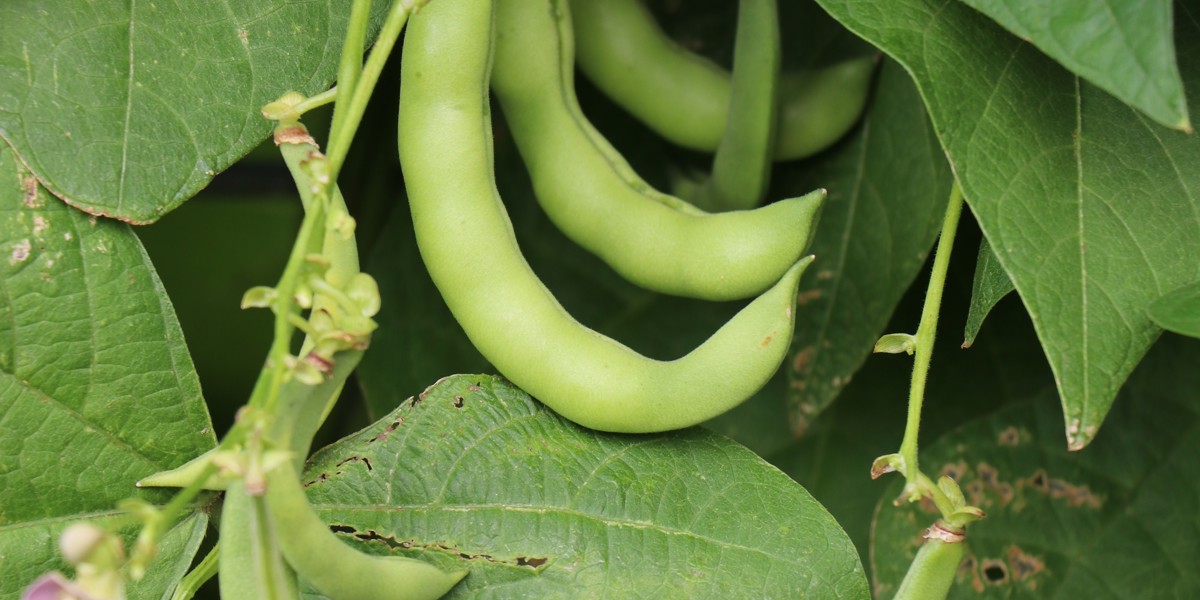
Summer bean trial
Most productive beans for Auckland
Introduction
Beans are a popular edible annual plant that can be eaten fresh or stored for a long time. They can be used in many ways such as picking beans directly off the plant for eating raw or cooked, shelling out or drying for cooking later. The majority of beans represented in this trial are Phaseolus species which originate from Central and South America.
In the past at Auckland Botanic Gardens (ABG) there have been many climbing beans (Phaseolus) grown in the Edible Garden but none have been formally trialled and assessed. Cultivars previously grown at ABG include P. Borlotti types, P. ‘Neekar Golden Runner’, P. ‘Yard Long Red Noodle’ and P. ‘Italian Flat Runner’. Beans grow best in sunny sites with little shade or competition. They are often planted with other species to provide some wind protection. Once established, bean plants require little maintenance.
The aim of this trial was to select edible climbing beans that grow well in Auckland conditions with good disease resistance, heavy cropping and strong growth. The trial included a range of climbing bean cultivars such as those for use as freshly cooked green beans, shelling out, and those for drying. The pods of green- or snap-beans are harvested and consumed before the seeds (beans) inside mature. Shell-out beans are harvested when the seed is full and mature inside the pod, but before the pod starts to shrivel. Shell-out beans have seeds removed and are cooked before eating, like broad beans. Dry beans are ones that are harvested when the pod starts to dry out and seeds can be stored for a long time before use. Dry beans need soaking before cooking and consuming.
Methods
Bean seeds of 44 cultivars were sourced from several companies including Kings Seeds, Koanga Gardens, Running Brook Seeds and the Egmont Seed Company. Prior to planting the soil was tilled to a depth of around 15 cm and blood and bone was incorporated in rows below the trellis. Organic seaweed soil enricher, Biofert, was added over the surface of the whole site and then overtopped by a layer of mulch. Seeds were sown directly in the bed in the trial garden at the end of October 2017. Twenty bean seeds of each cultivar were sown at a depth of around 2–2.5 cm at 10 cm spacing. Once plants had started to climb the trellis they were thinned out to 10 plants per cultivar. Plants were watered every 2–3 days with soaker hoses for 45 minutes.
Plants were assessed mainly on their quantity of bean production over the growing season, and pest and disease resistance. Cultivars were harvested 3–4 times during the season and the total number of beans counted, then the average calculated for each plant. Cultivars were classified as having light (less than 50 pods per plant), light-medium (50–100 pods per plant), medium (100–150 pods per plant) and heavy (more than 150 pods per plant) cropping. The fruiting period was recorded with the first and last fruiting date. Using the Royal Horticultural Society (RHS) colour chart, the bean colour was recorded. Observations of pests and diseases were recorded monthly. Overall plant evaluations were conducted by staff in January and March to assess overall performance. The trial concluded in early April 2018.
An overall rating (1 = poor performer and 10 = excellent performer) was used to determine the list of top performers. Cultivars that scored 8 or more were considered top performers and are recommended for Auckland based on the results of these trials.
Beans were not formally taste tested during this trial as this quality is subjective and varies according to individual preferences.
Results
Phaseolus coccineus ‘Sutton’s Giant’ did not germinate, so could not be evaluated further.
Most cultivars began fruiting in late December. However, some were very late to start fruiting, including P. ‘Asian Winged’ in mid-March, P. ‘Jackson Wonder Pole’ and P. ‘Yard Long Red Noodle’ which first started fruiting in late-January (Table 1).
Minimal pests and diseases were recorded on any cultivar so there was no need to score these observations in Table 1. There were small amounts of snail damage (less than 1%) on all cultivars but no powdery mildew. There was some foliage dieback on old foliage of P. ‘Gold Marie Vining’, P. ‘Italian Flat Runner’ and P. ‘King of the Blues Runner’.
P. ‘Snake Bean’ and P. ‘Yard Long Red Noodle’ are both sprawling rather than climbing cultivars. P. ‘American Pea Bean’ has a lot of foliage over the plants which means beans are hidden and harder to find for harvest.
Table 1 Summary information for 43 bean cultivars trialled including fruiting period, pod/bean colour using RHS colour charts, culinary uses, quantity of cropping (light = L, light/medium = LM, medium = M, heavy = H) and overall rating. (* indicates that beans are produced right down to the base of the plant).
|
Bean name |
Fruiting period |
Pod/bean colour |
Use |
Quantity of fruit (pods) per plant |
Overall rating |
||
|
Green / snap bean |
Shell out |
Dry |
|||||
|
Phaseolus coccineus ‘Scarlet Runner Goliath’ |
Late Dec to March. |
Yellow-green group 144A. |
x |
|
|
36 (L) |
7 |
|
Phaseolus coccineus ‘Scarlet Runner Tenderline’ |
Mid-Dec to mid-March. |
Yellow-green group 144A. |
x |
|
|
25 (L) |
7 |
|
Phaseolus lunatus ‘Christmas Limas’ |
Early Jan to March. |
Green group 143A. |
|
x |
x |
63 (LM) |
7 |
|
Phaseolus lunatus ‘Jackson Wonder Pole’ |
Early Jan to April (still fruiting at end of trial). |
Green group 143C. |
|
x |
x |
64 (LM) |
6 |
|
Phaseolus lunatus ‘Lima Del Papa Runner’ |
Mid-Jan to early March. |
Green group 143B. |
x |
|
|
36 (LM) |
6 |
|
Phaseolus lunatus ‘Persian Lima’ |
Mid-Jan to mid-March. |
Green group 143C. |
|
|
x |
124 (M) |
6 |
|
Phaseolus vulgaris ‘American Pea Bean’ |
Late Dec to March. |
Green group 143C. |
x |
x |
x |
149 (M) |
7 |
|
Phaseolus vulgaris ‘Blue Lake Runner’ |
Late Dec to mid-March. |
Green group 143C. |
x |
|
|
122 (M) |
7 |
|
Phaseolus vulgaris ‘Borlotti Pea Bean’ |
Late Dec to March. |
Green and red speckled. |
|
x |
|
105 (M) |
6 |
|
Phaseolus vulgaris ‘Calypso Red and White Bean’ |
Late Dec to mid-March. |
Yellow group 3C. |
|
x |
x |
130 (M) |
7 |
|
Phaseolus vulgaris ‘Cherokee Trail of Tears’ |
Early Jan to mid-March. |
Yellow-green group 144B with purple haze when old. |
x |
x |
|
184 (H) * |
8 |
|
Phaseolus vulgaris ‘Climbing America’ |
Late Dec to March. |
Green group 143C with purple streaks when old. |
x |
|
|
71 (LM) |
6 |
|
Phaseolus vulgaris ‘Climbing Borlotti Stoppa’ |
Late Dec to mid-March. |
Green group 142B. |
|
x |
x |
131 (M) |
7 |
|
Phaseolus vulgaris ‘Climbing Butter’ |
Mid-Dec to March. |
Yellow group 5C. |
x |
|
|
81 (LM) |
6 |
|
Phaseolus vulgaris ‘Climbing Cobra’ |
Late Dec – March. |
Green group 143C. |
x |
|
|
134 (M) |
7 |
|
Phaseolus vulgaris ‘Climbing Crystal French’ |
Late Dec to March. |
Yellow-green group 144B. |
x |
|
|
184 (H) * |
8 |
|
Phaseolus vulgaris ‘Climbing Dalmatian Pean’ |
Early Jan to March. |
Yellow-green group 144B. |
x |
x |
x |
105 (M) |
7 |
|
Phaseolus vulgaris ‘Climbing Emu’ |
Late Dec to March. |
Yellow-green group 144B. |
x |
|
|
206 (H) |
8 |
|
Phaseolus vulgaris ‘Climbing King George’ |
Mid-Dec to mid-March. |
Red group 53C with cream patches. |
x |
x |
x |
73 (LM) * |
7 |
|
Phaseolus vulgaris ‘Climbing Market Wonder’ |
Late Dec to March. |
Green group 143C. |
x |
|
|
55 (LM) |
7 |
|
Phaseolus vulgaris ‘Climbing Norridgewok Pean’ |
Late Dec to mid-March. |
Yellow group 6D. |
x |
x |
x |
31 (L) * |
7 |
|
Phaseolus vulgaris ‘Climbing Purple’ |
Late Dec to mid-March. |
Violet-blue group N92A. |
x |
|
|
179 (H) * |
8 |
|
Phaseolus vulgaris ‘Climbing Purple Pod’ |
Late Dec to March. |
Purple group N79A. |
x |
|
|
96 (LM) * |
7 |
|
Phaseolus vulgaris ‘Climbing Selugia’ |
Late Dec to March. |
Yellow-green group 144B. |
|
|
x |
139 (M) * |
8 |
|
Phaseolus vulgaris ‘Dalmatian Bean’ |
Mid-Dec to March. |
Yellow-green group 144D with purple group 79A speckles. |
x |
|
|
64 (LM) |
6 |
|
Phaseolus vulgaris ‘Fat Goose Bean’ |
Late Dec to mid-March. |
Red group 49A. |
|
x |
x |
66 (LM) |
7 |
|
Phaseolus vulgaris ‘Flagg Bean’ |
Mid-Dec to mid-March. |
Yellow-green group 144B with hint of purple when old. |
|
|
x |
71 (LM) * |
7 |
|
Phaseolus vulgaris ‘Gold Marie Vining’ |
Late Dec to early Feb. |
Yellow group 8B. |
x |
|
|
68 (LM) |
6 |
|
Phaseolus vulgaris ‘Good Mother Stallard’ |
Late Dec to mid-March. |
Creamy green with pink splashes. |
|
|
x |
144 (M) * |
7 |
|
Phaseolus vulgaris ‘Green Anellino Bean’ |
Late Dec to mid-March. |
Yellow-green group 144D. |
x |
|
x |
110 (M) * |
8 |
|
Phaseolus vulgaris ‘Henry’s Climbing Butter’ syn. ‘Henry’s Yellow Pole’ |
Mid-Dec to March. |
Yellow group 8B. |
x |
|
|
81 (LM) |
7 |
|
Phaseolus vulgaris ‘Hidatsa Shield Figure’ |
Late Dec to March. |
Green group 143C. |
|
|
x |
114 (M) |
6 |
|
Phaseolus vulgaris ‘Italian Flat Runner’ |
Mid-Dec to March. |
Green group 143C. |
x |
|
|
107 (M) * |
7 |
|
Phaseolus vulgaris ‘Italian Green Bean’ |
Mid-Dec to March. |
Yellow-green group 144D. |
x |
x |
|
149 (M) * |
7 |
|
Phaseolus vulgaris ‘King of the Blues Runner’ |
Mid-Dec to March. |
Greyed-purple group N186B. |
x |
|
|
109 (M) |
7 |
|
Phaseolus vulgaris ‘Lazy Housewife Runner’ |
Late Dec to mid-March. |
Green group 143C. |
x |
|
|
93 (LM) * |
7 |
|
Phaseolus vulgaris ‘Mangere Pole’ |
Late Dec to March. |
Green group 143C. |
x |
|
|
95 (LM) |
7 |
|
Phaseolus vulgaris ‘Neekar Golden Runner’ |
Mid-Jan to early March. |
Yellow group 5C. |
x |
|
|
43 (L) |
7 |
|
Phaseolus vulgaris ‘Shiny Fardenlosa’ |
Late Dec to mid-March. |
Yellow-green group 144A. |
x |
|
|
69 (LM) * |
6 |
|
Phaseolus vulgaris ‘Vitalis Runner’ |
Late Dec to mid-March. |
Yellow-green group 144B. |
x |
|
|
49 (L) |
6 |
|
Psophocarpus tetragonolobus ‘Asian Winged’ |
Mid-March to April (still fruiting at end of trial). |
Yellow-green group 146C. |
x |
|
|
9 (L) |
4 |
|
Vigna unguiculata subsp. sesquipedalis ‘Snake Bean’ |
Mid-Jan to mid-March. |
Yellow-green group 146D. |
x |
|
|
10 (L) |
4 |
|
Vigna unguiculata ‘Yard Long Red Noodle’ |
Late Jan to April (still fruiting at end of trial). |
Red-purple group 59A. |
x |
|
|
30 (L) |
4 |
Based on Table 1, we can rank the top 10 most productive beans and include their culinary uses (green = G, shell out = S, dry = D):
P. ‘Climbing Emu’ (G)
P. ‘Cherokee Trail of Tears’ (G/S)
P. ‘Climbing Crystal French’ (G)
P. ‘Climbing Purple’ (G)
P. ‘Italian Green Bean’ (G/S)
P. ‘American Pea Bean’ (G/S/D)
P. ‘Good Mother Stallard’ (D)
P. ‘Climbing Selugia’ (D)
P. ‘Climbing Cobra’ (G)
P. ‘Climbing Borlotti Stoppa’ (S/D).
Harvest notes
Green beans should be picked when pods are young and supple. Shell out beans can be cooked fresh or dried, so pick them when the seeds in the pods are maturing and almost at full size. Dry beans are best left until the pods are fully mature before picking. Dry beans can either be left to dry on the vine or picked and dried off the vine.
While picking beans we made notes on cultivars that had slightly different picking times and requirements:
• Some beans were much easier to pick than others as some snap off half the bean or have a sharp point at the end of the bean. We found P. ‘Climbing Cobra’ difficult to pick.
• Borlotti types should be picked when pods start to crack or left on the plant until the pods dry to a tan colour before picking and drying further. Dry the beans for approximately 1–2 weeks or longer before using.
• Pick Lima types when pods are green but well filled.
• P. ‘Gold Marie Vining’ is best picked when pods are young but quite long.
• P. ‘Good Mother Stallard’ is best picked when beans are large and pods turn yellow. P. ‘Hidatsa Shield Figure’ should be picked when pods turn creamy in colour. P. ‘Yard Long Red Noodle’ beans are best picked when the pods are pencil thickness.
• Pick P. ‘Asian Winged’ when young and bright green to use the whole pod.
Conclusions
We recommend the following six star performers:
P. ‘Cherokee Trail of Tears’
P. ‘Climbing Crystal French’
P. ‘Climbing Emu’
P. ‘Climbing Purple’
P. ‘Climbing Selugia’
P. ‘Green Anellino Beans’
These are recommended for Auckland based on the highest quantities of fruit produced, lack of pest and disease issues, and with an overall rating of 8. P. ‘Climbing Selugia’ and P. ‘Green Anellino Beans’ had medium (rather than heavy) cropping but were sufficiently impressive to gain high overall ratings.
Some of the other cultivars that were rated at 7 could also be worth growing and the total yield might have been greater if the frequency of harvest was more often than in this trial.
Acknowledgements
Thanks to Yvonne Baker, Tynan Burkhardt and Laurence Speedy for researching and collecting the data and harvesting beans during this trial. We also thank Auckland Council corporate volunteers for doing the final bean harvest and Botanic Garden volunteers (Ross Sharp, Isobel Murphy and Karen Katavich) for counting beans.
References
Egmont Seed Company
Heritage Food Crops Research Trust: Heirloom Beans
Kings Seeds
Kirian Farms: Running Brook Seeds. Mail Order Catalogue (2017–2018): www.kirianfarms.co.nz/uploads/1/0/2/9/102952444/running_brook_catalogue_online_3.7.17.pdf.
Koanga Gardens: Online shop
Lyle, S. (2009). Discovering vegetables, herbs and spices. Auckland, New Zealand: David Bateman Ltd.
This article cannot be republished elsewhere without consent from Auckland Botanic Gardens.




